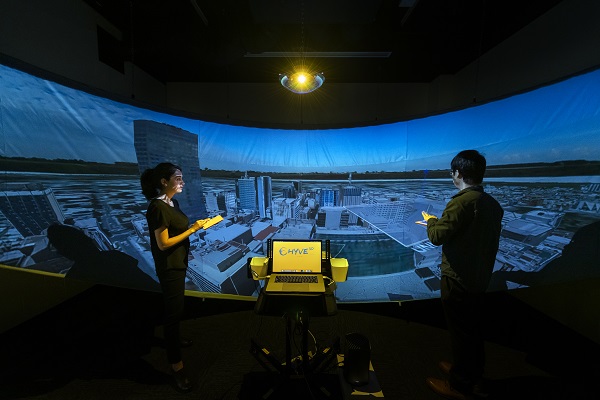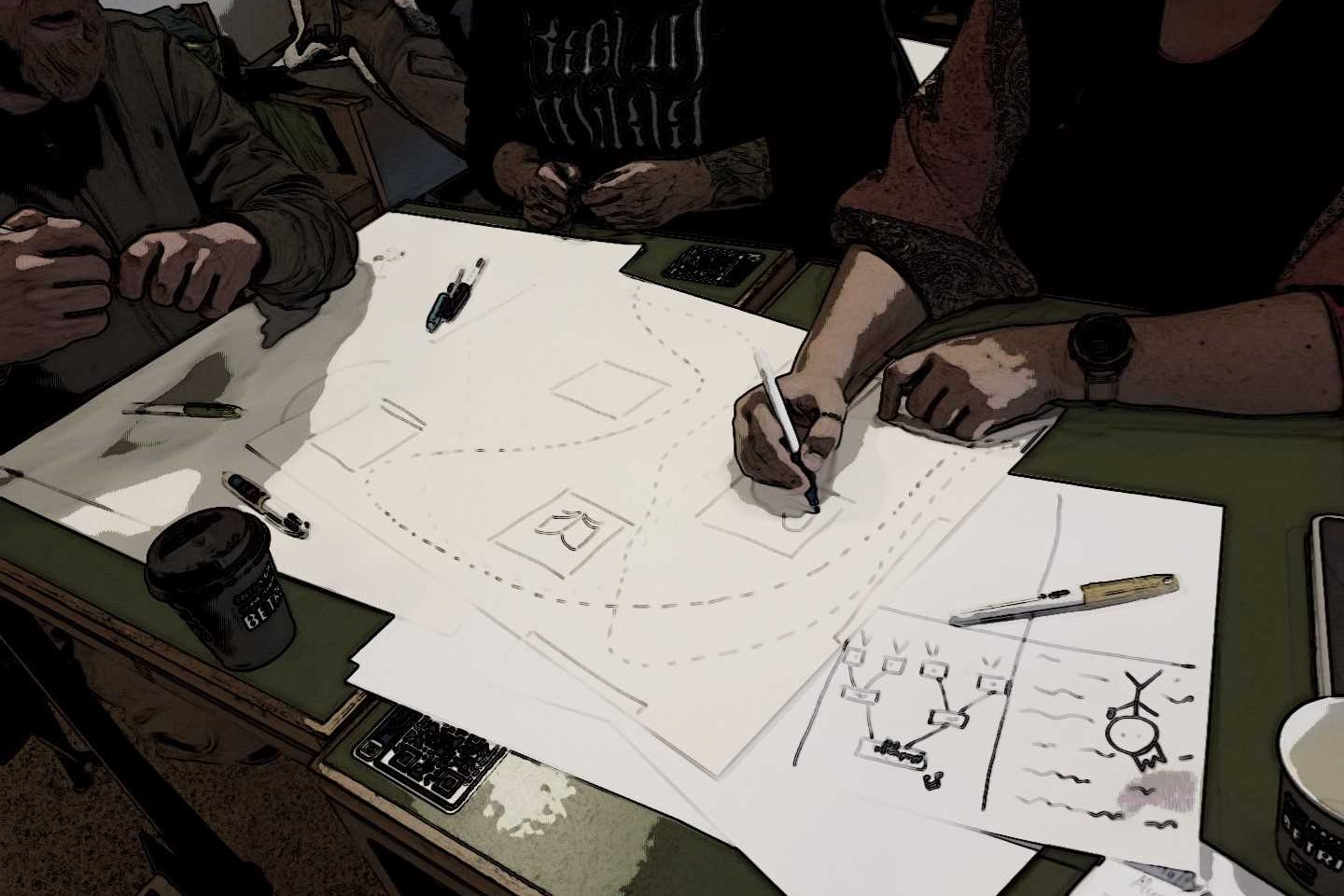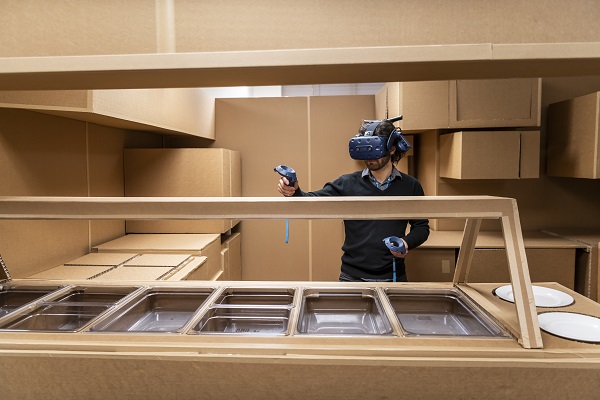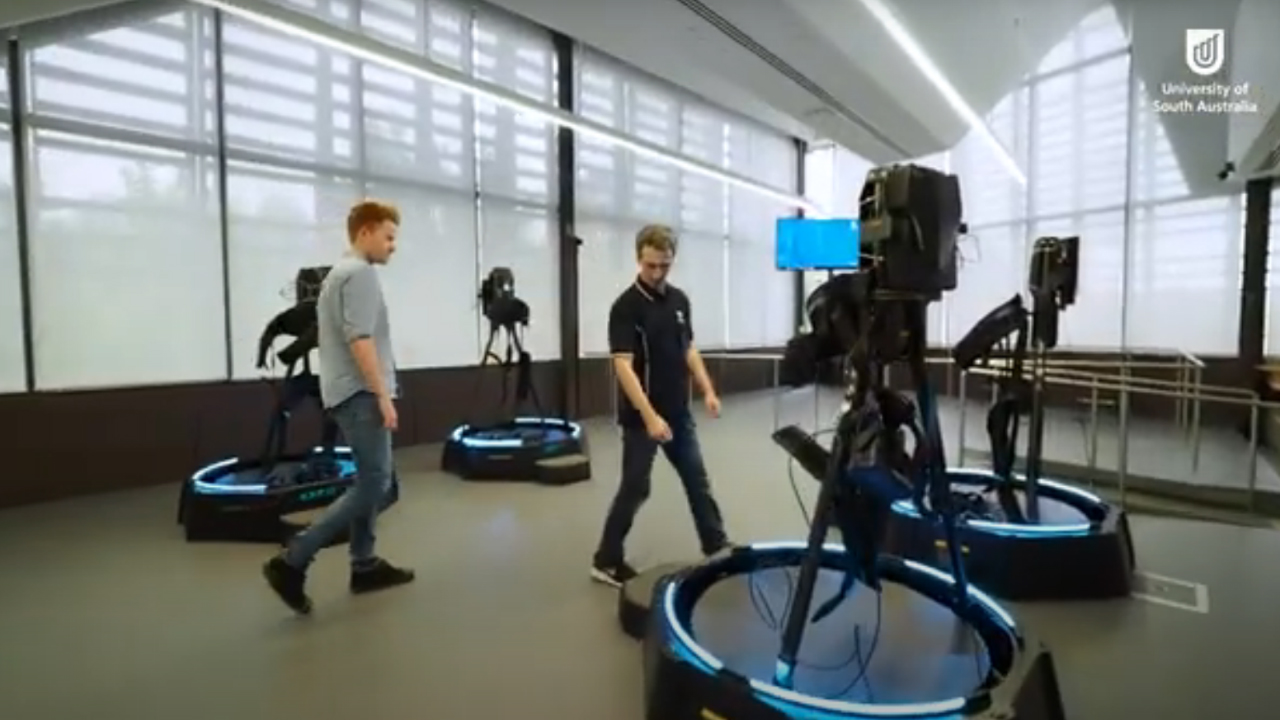Australian Research Centre for Interactive and Virtual Environments
The rapid pace of global change is driving many new social, economic, and environmental challenges. Research at the University of South Australia has been positioned around key industries to ensure we can deliver innovative and sustainable solutions that respond to the most pressing needs of our world.
In the short videos, IVE members explain their research and how we engage with industry, collaborate with other academic institutions, and provide world-class education. Details about the research capabilities within each of our labs have also be detailed below.
To find out how we can assist your organisation, please contact IVECentre@unisa.edu.au.
Learn more about our research capabilities
Discover our labs
The Australian Research Centre for Interactive and Virtual Environments (IVE) at the University of South Australia (UniSA) is the largest concentrations of Virtual Reality/Augmented Reality researchers in Australia and provides various resources and facilities for Mixed Reality research and development. IVE not only has over 130 researchers and the latest cutting-edge research facilities but also has close collaboration with various research groups and companies across Australia and around the world, especially in the Australasian region through the ARIVE research network.
-
Building and Urban Informatics
Building and Urban Informatics
Building the future of architecture, construction and planning design
The Building and Urban Informatics Group undertakes hybrid and collaborative research exploring computational and simulation systems across the disciplines of architecture, construction, and urban and regional planning. The group employs state-of-the-art facilities and methods for conducting computational visualisation, analysis, fabrication, and collaboration research, supporting contemporary design, building, and planning studies.
The group employs advanced tools and approaches for simulation, computational design, planning and analysis, information management and collaboration, and prototyping and fabrication, which supports a wide range of research projects in design, building, and urban and regional planning. The advanced facilities and innovative techniques include virtual, augmented, and mixed reality, including the immersive Hyve-3D collaborative design environment, urban analytics utilising big data and GIS, digital prototyping, 3D printing and fabrication, and more. These systems are applied in research in areas such as:
- architectural style and design culture
- building, construction, and waste project management
- collaborative practices in the housing sector
- design cognition
- digital and virtual heritage
- environmental and social sustainability
- smart cities and urban information management
- transport and infrastructure planning
- virtual architecture and Metaverse


The group is currently comprised of researchers and higher degree by research students and assistants, whose projects have been generously supported by major funding agencies, including the Australian Research Council, Department of Education and Training, Cooperative Research Centre for Construction Innovation, and Cooperative Research Centre for Low Carbon Living.
Members
Leaders
- Dr Jorge Ochoa Paniagua - Senior Lecturer
- Dr Rongrong Yu - Enterprise Fellow
Academic Staff
- Professor Ning Gu - Professor in Architecture
- Associate Professor Rhoda Abadia - Associate Dean: UniSA Online
- Dr Andrew Allan - Senior Lecturer
- Dr Robert Doe - Lecturer: Architecture
- Dr Mehdi Amirkhani - Online Course Facilitator
- Dr Ben Stubbs - Senior Lecturer
- Dr Sadasivam Karuppannan - Senior Lecturer
- Dr Julie Nichols - Lecturer: Architecture
- Dr Alpana Sivam - Research Degree Coordinator
- Dr Rosa Teimouri - Lecturer
- Dr Thilini Jayawickrama - Program Director
- Dr Kevin Zheng Wang - Lecturer
- Dr Madhavee Mahinkandra - Lecturer
- Dr Ruchini Jayasinghe - Online Course Facilitator
- Ms Zahra Yousefi - Research Associate
- Mr Darren Fong - Lecturer: Digital, Construction and Professional Practice
Postgraduate Students
- Adii Shtykov
- Bashar Almosuli
- Chathuri Widanalage
- Dulini Rathnayake Mudiyanselage
- Elita Nuraeny
- Hamidreza Sakhaei
- Jiang Wu
- Madeleine Parkyn
- Natale Zappia
- Nurul Fakriah
- Ran Zhou
- Rasoul Rafat
- Shaila Maheshwari
- Songkai Jia
- Soroush Masoumzadeh
- Trevor White
- Xinyang Feng
- Yue Dong
Adjunct Members
- Dr Sahar Soltani - Adjunct Research Associate
Affiliate Members
- Dr Guy Keulemans - Enterprise Fellow
External Members
- Professor Ali Soltani
-
Cognitive Neuroscience
Cognitive Neuroscience
Conducting state-of-the-art research into the neurobiological underpinnings of cognition
We specialise in studying cognition and performance not just in the lab but also under real-world conditions. Our main areas of research include:
- language
- memory
- the effects of sleep on cognition
- human performance in complex environments
We collaborate with other laboratories in IVE and external partners to examine real-time measures of cognitive workload in a variety of interactive and virtual environments. The CNL is located in a dedicated research facility at the UniSA Magill campus. We have the capability to run experiments using:
- Electroencephalography (EEG), allowing for a range of data collection methods including ultra-mobile, high density, and hyper scanning (concurrent EEG measures from multiple individuals)
- Eye-tracking
- Transcranial magnetic stimulation (TMS)
- Physiological measures such as skin conductance and heart rate
- Various behavioural methods


Members
Leader
- Professor Ina Bornkessel-Schlesewsky - Professor: Cognitive Neuroscience
Academic Staff
- Dr Alex Chatburn - Lecturer
- Professor Matthias Schlesewsky - Professor
Postgraduate Students
- Ashley Platt
- Daniel Rogers
- Hayley Caldwell
- Tabitha McLoughney
- Thinvina Thanabalan
-
Creative Computing Studio
Creative Computing Studio
Supporting research projects at the nexus of the creative arts, design and human computer interaction
The Creative Computing Studio - CCS - features multi-modal interaction facilities, including Optitrack 12 camera full-body motion capture, Kinect Azure motion tracking, gesture recognition, voice recognition, virtual and augmented reality, and surround sound systems. We were a founding partner of the Collaborative Embodied Movement Design Network, a project supported in part through the Australian Research Council's Linkage Infrastructure, Equipment, and Facilities fund, including research partners in Australia and internationally. Together with our partners, we developed a national collaborative network of arts/technology researchers, enabling collaboration to optimise the quality of these systems from an embodied perspective creating innovative possibilities for fabrication, industry, commerce, education, health care, and the creative arts.
Our areas of expertise and application development include the following:- Interactive visual arts (interactive installations, virtual reality applications)
- Interactive performance environments
- Electronic literature
- Online and virtual pedagogy
- Computer gaming, multi-person communication, and collaboration systems
- Architectural visualisation applications, including in cultural restoration projects
- Rapid prototyping and assembly
Our facility is comprised of a 67 square metre dedicated area for human-computer interaction and is fully networked for live streaming between local and remote systems.


Members
Leader
- Dr Deirdre Feeney - Lecturer: Contemporary Art
Academic Staff
- Mr David Blaiklock - Program Director: Bachelor of Design (Illustration and Animation)
- Mr Steve Kelly - Lecturer: Interior Construction/Digital
- Dr Josh McCarthy - Program Director: Media Arts
- Dr Sarah Neville - Academic Researcher
- Dr Sean Pickersgill - Senior Lecturer: Architecture
- Dr Kim Munro - Lecturer
Adjunct Staff
- Professor Simon Biggs - Professor of Art
- Mr Greg Donovan - Adjunct Senior Lecturer
- Professor Tim Gruchy - Adjunct Research Professor
Affiliate Staff
- Dr Ash Tower - Academic Researcher
External Members
Postgraduate Students
- Andrew Lymn-Penning
- George Martin
- Katherine Bell
- Megan Roodenrys
- Tara Rowhani-Farid
- Yan Wang
-
Design for Health and Wellbeing
Design for Health and Wellbeing
Merging design, healthcare, and immersive digital experiences in order to help tackle major health and wellbeing issues
Design Research for Health and Wellbeing (DRHW) is home to a cross-disciplinary network of researchers, computer scientists, creative practitioners, healthcare workers, and service users. An emphasis on the use of design and design research allows for the development and prototyping of objects, environments, systems, and services to improve the experience of healthcare and healthcare delivery.
We are particularly interested in the application of AR, VR, SR, and Mixed Reality technologies in the patient journey and the training of healthcare professionals. We are also interested in the creation of inclusive visualisation techniques and interfaces such as data physicalisation, to assist non-specialist audiences making better sense of data.
Our industry partners include hospitals, care villages, local government, health education, design, and architectural firms. We work on a wide range of health and wellbeing related health issues including non-communicable disease management, preventative care, antibiotic resistance, and ageing communities.


The Design Clinic
Part of the Design Research for Health and Wellbeing group, The Design Clinic provides the design and specialist facilitation of co-design workshops that use design thinking and participatory research methods to help care providers and care users better understand and communicate the lived experience of health care. We work with a wide range of co-design tools including Lego serious play, and distributed participant collaborative software such as Miro.
Members
Leaders
- Professor Ian Gwilt - Research Professor: Design
- Associate Professor Fanke Peng - Enterprise Fellow
Academic Staff
- Dr Aaron Davis - Research Associate
- Dr Kate Little - Lecturer / Research Fellow
- Dr Ghazaleh Sepahpour - Lecturer
- Dr Shokry Abdelaal - Program Facilitator
- Dr Kath Dooley - Associate Professor
Affiliate Members
- Associate Professor Veronika Kelly - Associate Professor in Design
- Dr Mike Musker - Enterprise Fellow
Postgraduate Students
- Agarrid Dhaifallah Mahdi
- Amanda Kelly
- Darren Talijaard
- Lorraine Marchioro
- Madeline Zabar
- Mahsa Makki Alamdari
- Nikou Javadi
- Rebecca Stewart
- Richard Khoo
- Rui Zhang
-
Empathic Computing
Empathic Computing
Bridging the emotional gap between humans and technology
The Empathic Computing Laboratory (ECL) is an academic research collaboration between the University of South Australia and the University of Auckland and explores new ways for technology to enable people to better understand one another.
Empathy is about seeing with the eyes of another, listening with the ears of another, and feeling with the heart of another. Empathic Computing is a research field that develops computer systems that recognise and share emotions and help people better understand one another. Our team is working to make empathic computing mainstream and investigate both software and hardware components to enable this technology, along with researching the usability of such interfaces.
Research themes:
- Empathic Computing
- Collaborative Interfaces
- Augmented Reality/Virtual Reality/Mixed Reality Interfaces
- Virtual Training and Education
- Virtual Tourism


Members
Leader
- Professor Mark Billinghurst - Professor of Human Computer Interaction
Academic Staff
- Dr Gun Lee - Senior Lecturer
- Dr Tobias Loetscher - Senior Lecturer: Psychology
- Associate Professor Paul Lee - Program Director
- Dr Theo Teo - Postdoctoral Research Fellow
Affiliate Staff
- Dr Jun Anh- Adjunct Senior Research Fellow
- Dr Siamak Mirzaei - Online Course Facilitator
- Dr Ancret Szpak - Research Associate
Postgraduate Students
- Ashkan Farrokh Hayati
- Bowen Yuan
- Dmitry Resnyansky
- Emma Sheffield
- Hanaa Ibrahim
- Hugo Tian
- Hyunwoo Cho
- Jason Dow
- Kaining Zhang
- Louise Lawrence
- Urich Nandagopal
- Xuan Tien Pham
-
Playful Cultures
Playful Cultures
Exploring the intersections of play, culture, and immersive discovery
The Playful Culture Lab specialises in taking play seriously, adopting and applying engaging challenges inherent in games to cultural and social activities, challenges, and opportunities.
Our main areas of research include:
- Digital heritage (and especially virtual heritage).
- Digital tourism (and intersecting aspects of digital humanities).
- Interactive environments for cultural learning with a focus on playful mechanics and interfaces.
- Social issues and serious games.
- Environmental storytelling through play.
We collaborate with universities, social groups and cultural industries, game companies, and designers, in Australia and internationally. We have designed award-winning games, presented award-winning papers, and consulted with game companies, national and international research organizations, UNESCO, and NGOs.
We are currently located on the UniSA Magill campus and the UniSA City West campus.


Members
Leader
- Associate Professor Erik Champion - Enterprise Fellow
Academic Staff
- Dr Susie Emery - Lecturer
- Dr James Calvert - Senior Lecturer in Animation
- Dr KJ Hepworth - Senior Research Fellow
Postgraduate Students
- Alaa Aljurais
- Fadilah Arief
- Sophia Booij
-
Studio for Complex Human Environment Design
Studio for Complex Human Environment Design
The Studio for Complex Human Environment Design (SCHED) is a multidisciplinary design studio developing processes, methods, and knowledge to design and develop complex human environments
Our research uses Human Centred Design (HCD) practices to understand how people work and live in these highly technical, high risk and complex environments to improve the human experience and usability. These include isolated and confined environments (ICE) or spaces that house high-stakes, high-intensity activities such as submarines, ships, space crafts, medical facilities, and Antarctic buildings.
We transform spaces using our HCD expertise, along with Computer-Aided Design (CAD) modeling, Virtual Reality (VR) simulations, human experience studies, anthropometry, and physical model building. Alongside other research groups within the university, including those specialising in biomechanics, psychology, and interactive and virtual environments, we work to develop integrated solutions that address technical, physiological, and psychological requirements.
The people who live and work in these spaces are at the core of the process. A range of different methods are used to engage with users and the physical context throughout the process. This ensures the design team understands people’s activities and needs so that the design proposal is fit for purpose.
We access a range of workshops and physical prototyping facilities, which we use to construct functional models of various levels of complexity. These are used throughout the project and are key tools during development, engagement, and communication. Within our studio, we build physical, to-scale models of spaces using inexpensive and recyclable materials, like cardboard, enabling researchers and the client to understand the space and how users will interact with it.
The outcome is a grounded, practical, user-focused design proposal expressed using physical prototypes, virtual reality, fly-throughs, and functional artefacts. The process is documented using literature reviews and reports of the user engagement workshops and outcomes, providing evidence-based for the design. In summary, HCD puts people at the heart of the process. It is an iterative practice that begins with empathy for the people we are designing for and invites their input throughout the project.
We have worked closely with defence industries, including DST, Lockheed Martin Australia, Naval Group Australia, SAAB Australia, and the Royal Australian Navy. Through our projects, we have developed a rich and deep understanding of what it is like to live in these isolated and confined environments for defence personnel and submariners. More recently, we have provided input to the design of rooms within South Australia’s new Women’s and Children’s Hospital. We designed and built life-size mock-ups of clinical rooms out of cardboard to assist clinicians, other staff, and consumers visualise the size and proposed layout. The temporary mock-up rooms allowed staff and consumers to experience and orientate themselves with the proposed room layouts early in the design phase.



Members
Leader
- Dr Peter Schumacher - Senior Lecturer
Postgraduate Students
- Simon Modra
-
Wearable Computing
Wearable Computing
Future-focused research with real-world applications
The Wearable Computer Lab explores all areas of human-computer and human-machine interaction, with an extensive focus across augmented and virtual reality, visualisation, wearables, and future technologies. The lab has expertise in:
- Novel virtual and augmented/mixed reality interaction systems and techniques
- electro-mechanical device prototyping and development
- Immersive visualisation and analytics of big data across industries
- Projector based augmented reality
- Natural human-machine interfaces with body and hand interaction
From its founding in 1998, the lab has developed and employed cutting-edge technologies to explore what the future may hold, both in fundamental and applied technologies across a variety of domains including health, mining, manufacturing, construction, and defence. Comprised of a globally and culturally diverse set of researchers, academics, research students, and assistants, the lab’s global reach in partnerships and research has led to WCL alumni being located at industry and research organisations around the world.
Working alongside IVE’s other research groups, the WCL explores human-computer interaction from all angles including human factors, ergonomics, design, creativity, and human psychology. We work on both industry-focused and research-focused projects, delivering outcomes for both academia and industry stakeholders.


Members
Leaders
- Dr Andrew Cunningham - Senior Lecturer
- Dr James Walsh - Enterprise Fellow
Academic Staff
- Professor Tom Raimondo - Professor in Geology and Geochemistry
- Associate Professor Stewart Von Itzstein - Program Director
- Dr Jo Zucco - Program Director
- Dr James Baumeister - Research Fellow
- Dr Ben Volmer - Research Associate
- Dr Adam Drogemuller - Research Associate
- Mr Nicolas Barbotin - Research Associate
- Dr Nick Fewster-Young- Program Director
- Mr Jack Fraser - Research Assistant
- Mr Alex Pepicelli - Research Assistant
Emeritus & Adjunct Staff
Affiliate Members
- Dr Paul Unsworth - Lecturer: Primary Sciences/Maths Education
External Members
- Dr Henry Gardner
- Dr Carolin Reichherzer
- Dr Jacob Ross
Postgraduate Students
- Catherine Barnes
- Chenkai Zhang
- Corey Martin
- Jamie Gower
- Jasmine Nguyen
- Juan Pieschacon
- Kingsley Stephens
- Radhika Jain
- Rory Thoman
- Spencer O'Keeffe
- Thi Thanh Hoa Tran
- Thomas Clarke
- Tianye Miao
- Venus St Germain
- Xiaojiao Du


















